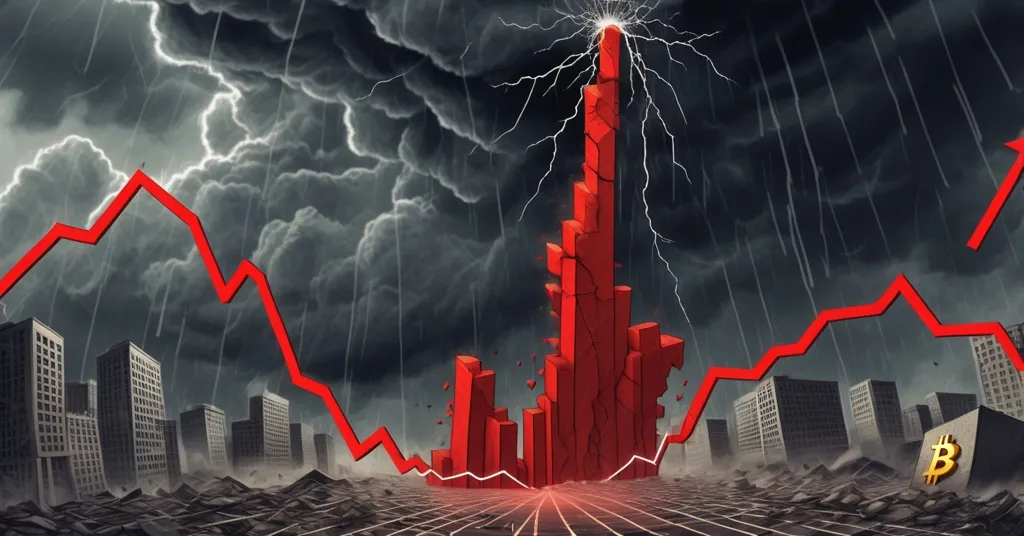Bitcoin Plummets to $93K: Fed Rate Cut Doubts Spark Crypto Bloodbath

Bitcoin Crashes to $93K: Did the Fed Just Derail the Bull Run?
Bitcoin took a savage beating during Monday’s Asia market open, plummeting to $93,000 in its nastiest drop since March, as fading hopes for a December US Federal Reserve rate cut sent panic through crypto and traditional markets alike. With over $617 million in liquidations rocking the digital asset space and global stock indices flashing red, the question looms: is this a temporary stumble, or the start of a deeper slide?
- Bitcoin tanks to $93,000, worst drop since March, on Fed rate cut doubts.
- Crypto liquidations soar to $617.45 million in 24 hours, Bitcoin and Ether hit hard.
- Global markets retreat, with US, European, and Asian indices down sharply.
- Japan mulls tighter crypto rules, including insider trading laws and 20% tax.
Bitcoin’s $93K Nosedive: What Went Wrong?
The crypto king got knocked off its throne early Monday in Asia, with Bitcoin cratering to $93,000 before limping back to around $95,051, still down 0.7% for the day. The trigger? A drastic shift in market sentiment as expectations for a Federal Reserve rate cut in December collapsed from over 60% to just 40%, as reported in a recent analysis of the Asia market downturn. For those new to the space, a Fed rate cut means cheaper borrowing costs, which often pumps liquidity into high-risk plays like Bitcoin—a volatile investment that reacts sharply to macroeconomic vibes. When the likelihood of that stimulus fades, investors bolt for safer assets, leaving Bitcoin exposed to brutal sell-offs. This isn’t just a crypto problem; it’s a symptom of broader risk aversion gripping global markets right now.
Crypto Market Bloodbath: Liquidation Fallout
The pain didn’t stop at price charts. Data from CoinGlass reveals a staggering $617.45 million in crypto liquidations over a 24-hour span. Liquidations occur when traders using borrowed funds—known as leverage—can’t cover their losses, forcing platforms to forcibly sell their positions, often at steep discounts. Of this carnage, $394.50 million came from long positions (bets on price increases) and $222.95 million from shorts. Bitcoin took the heaviest blow with $242.19 million wiped out, followed by Ether at $169.06 million. The single biggest casualty? A $30.60 million Bitcoin position on Hyperliquid, a stark warning about the dangers of gambling with borrowed cash in this wild-west market. Frankly, platforms offering 100x leverage to retail traders are playing with fire—lesson learned: over-leveraging in crypto is a fast track to the poorhouse.
This level of liquidation signals systemic stress. Unlike traditional markets with circuit breakers, crypto trades 24/7, amplifying volatility when liquidity thins. For new traders, a word of caution: margin trading can multiply gains, but it just as easily multiplies losses. If you’re not ready to lose it all, stick to holding your coins in a secure wallet.
Global Markets in Retreat: A Domino Effect
Bitcoin’s woes aren’t happening in a vacuum. Traditional markets are also sounding the alarm, spooked by the same Fed uncertainty. On Friday, Wall Street bled with the Dow Jones Industrial Average down 1.65%, the S&P 500 off 1.66%, and the tech-laden Nasdaq Composite shedding 2.29%. Europe followed suit, with Germany’s DAX falling 1.39%, the UK’s FTSE 100 dropping 1.05%, France’s CAC 40 slipping 0.11%, and the Euro Stoxx 50 declining 0.83%. Monday’s Asia open was no better—Japan’s Nikkei 225 tumbled 1.77%, Australia’s S&P ASX 200 fell 1.35%, New Zealand’s benchmark dropped 1.58%, and Shanghai edged down 0.16%.
Why does this matter to crypto holders? When stock markets falter, investors often yank capital from speculative assets like Bitcoin to shore up losses or park funds in safer havens like bonds or cash. It’s a domino effect—global risk aversion starves high-volatility plays of oxygen, and Bitcoin, as a frontier asset, suffocates first.
Spot Bitcoin ETFs: Institutional Hesitance
Adding fuel to the fire, spot Bitcoin exchange-traded funds (ETFs) are seeing notable outflows, signaling even the big players are getting cold feet. For the uninitiated, spot ETFs are investment vehicles traded on stock exchanges that track Bitcoin’s price directly, letting folks invest without messing with wallets or private keys. Inflows into these funds often reflect institutional confidence; outflows, like we’re seeing now, suggest the suits are stepping back. While exact figures for specific funds like Grayscale or BlackRock’s iShares aren’t fully public for this week, the trend points to caution among deep-pocketed investors waiting for clearer economic signals. With liquidity drying up in crypto markets as a result, every price swing feels like a sledgehammer—fewer buyers and sellers mean bigger impacts from each trade. Even Wall Street can’t handle Bitcoin’s heat right now, it seems.
Japan’s Regulatory Hammer: Blessing or Burden?
Meanwhile, Japan—a historically key player in crypto adoption since the Mt. Gox days—is considering a regulatory overhaul that could reshape the game. The Financial Services Agency (FSA) is proposing to classify digital assets as financial products, subjecting them to insider trading rules, a flat 20% tax on gains, and mandatory disclosures for 105 listed tokens. On paper, this aims to curb market manipulation and protect investors, aligning crypto with traditional finance. It could legitimize the space, drawing in risk-averse institutions who crave regulatory clarity. Japan’s early embrace of Bitcoin, even post-Mt. Gox collapse, makes this move significant—potentially a model for others.
But let’s not kid ourselves: this is a bureaucratic straightjacket. Compliance costs could crush smaller projects and traders, while curbing the speculative freedom that’s fueled crypto’s rise. Compared to the EU’s MiCA framework or the US SEC’s heavy-handed crackdowns, Japan’s approach feels balanced but still risks stifling innovation. As advocates of decentralization, we see regulation as a double-edged sword—necessary for mainstream trust, but a direct threat to the permissionless ethos we fight for. Will Japan tame the beast, or choke its spirit?
Altcoins in the Mix: Ether, XRP, and Diversification
While Bitcoin reels, not all digital assets are drowning. Ether, the backbone of Ethereum’s smart contract ecosystem, dropped 0.7% to $3,172, reflecting similar macro pressures with $169.06 million in liquidations. Yet XRP, tied to Ripple’s cross-border payment solutions, defied the trend with a 0.4% uptick to $2.25. Why the resilience? Some point to Ripple’s legal wins against the SEC, boosting confidence, or XRP’s utility in niche financial use cases. Total crypto market cap still slid 0.9% to $3.31 trillion, but these altcoin divergences highlight their unique roles. As Bitcoin maximalists, we view BTC as the ultimate store of value, yet we can’t ignore how Ether powers decentralized apps or XRP fills gaps Bitcoin doesn’t touch. Diversification might just be a lifeline when the king stumbles.
Bitcoin’s Path Forward: Recovery or Ruin?
So, where does Bitcoin head from $93,000? Optimists see this as a buying opportunity—dips like this have historically preceded rallies if institutional conviction returns, perhaps via renewed ETF inflows or a surprise dovish pivot from the Fed. Bitcoin’s weathered worse storms; look at the 2018 bear market or the 2021 China mining ban. Each gut punch forged a tougher ecosystem. Yet, bears have a point: with liquidity thin and global risk appetite shrinking, a break below the psychological $90,000 barrier could spark panic selling. Some even argue Bitcoin’s tight correlation to macro trends disproves its status as an uncorrelated asset—has it just become Wall Street’s latest toy? We counter that long-term, Bitcoin’s decoupling from fiat systems remains its destiny, even if short-term pain stings. Recovery hinges on big money stepping up, but further wreckage isn’t off the table.
Key Questions and Takeaways on Bitcoin’s Crash
- What caused Bitcoin’s price to crash to $93,000?
A sharp drop in expectations for a December Fed rate cut, from over 60% to 40%, spooked investors, driving risk aversion and triggering sell-offs in Bitcoin. - How severe were the crypto liquidations?
Liquidations totaled $617.45 million in 24 hours, with Bitcoin at $242.19 million and Ether at $169.06 million, exposing over-leveraged positions and market stress. - Why are global stock markets also declining?
Uncertainty over Fed policy has fueled a risk-off mood, with major indices like the Dow (down 1.65%) and Nikkei 225 (down 1.77%) reflecting investor caution. - What’s behind the outflows from Bitcoin ETFs?
Institutional investors are pulling back amid macro uncertainty, reducing liquidity in crypto markets and amplifying price volatility with every trade. - How might Japan’s new crypto rules impact the market?
Classifying crypto as financial products with insider trading laws and a 20% tax could legitimize the space but burden smaller players with compliance costs. - Can Bitcoin recover from this $93K drop?
Recovery depends on institutional buy-in and economic shifts, but thin liquidity and ETF outflows keep the risk of further declines very real. - Why did some altcoins like XRP hold up better?
XRP’s slight 0.4% gain to $2.25 may stem from Ripple’s legal progress and its niche in payments, showing altcoins can diverge from Bitcoin’s path.
Decentralization Under Fire: A Test for Bitcoin
Bitcoin hitting $93,000 isn’t just a bad day on the charts—it’s a glaring reminder of the volatility we signed up for in this fight for financial freedom. As champions of decentralization, we view these crashes as growing pains on the road to disrupting a broken status quo. The Fed’s shadow looms large, proving why we need a system untethered from central bankers’ whims. Yet challenges like regulatory overreach, macroeconomic headwinds, and market mechanics test even the fiercest HODLers. Bitcoin remains our lodestar, but altcoins carve out vital niches. Through the lens of effective accelerationism, this shakeout weeds out speculative fluff, forging a stronger foundation. Are you ready to ride out the storm, or is the centralized fog too thick even for Bitcoin’s light?



